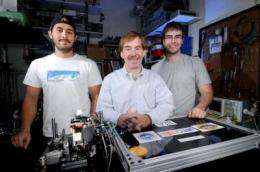Ultracold matter technology licensed to Boulder’s ColdQuanta

ColdQuanta Inc. of Boulder and the University of Colorado have finalized an agreement allowing ColdQuanta to commercialize cutting-edge physics research developed by CU-Boulder and SRI International. The licensed technology centers on Bose-Einstein Condensate, or BEC, a new form of matter created just above absolute zero.
Ultracold matter such as BEC can be used to dramatically increase the performance of devices such as gyroscopes, accelerometers, gravimeters and magnetometers because of its strong interaction with gravity and magnetic fields as compared with laser-based devices. BEC also has potential applications in a wide range of research and commercial settings, ranging from atomic clocks to improved navigation of submarines and spacecraft, and even quantum computing.
"We are delighted that this license agreement has been finalized," said ColdQuanta CEO Rainer Kunz. "It's a great example of the university's strong support for commercializing BEC and cold atom technology born out of CU and SRI International, and will ultimately boost advances in the ultracold applications field."
"Cold atom research has great potential for fields such as instrumentation and cryptography," added Chris Lantman, senior director of business development at SRI International of Menlo Park, Calif. "We are pleased that ColdQuanta will commercialize this important technology and look forward to new applications of our physics R&D."
Initially theorized by Satyendra Bose and Albert Einstein in the 1920s, BEC was achieved for the first time at JILA -- a joint institute of CU-Boulder and the National Institute of Standards and Technology -- by Eric Cornell and Carl Wieman, who received a Nobel Prize in 2001 for their work. ColdQuanta was founded in 2007 to commercialize work by CU-Boulder physics professor and JILA Fellow Dana Anderson to develop streamlined devices for BEC experiments.
"Startup companies like ColdQuanta play a pivotal part in the transition of an entirely new scientific domain into the realm of practical applications," said Anderson. "By now we have come full circle, so that they contribute to our scientific progress here at CU as much as our academic research advances their R&D progress."
"We're glad to see this forward-looking technology achieve commercial penetration, in addition to the strong academic interest," added Ted Weverka, a licensing manager at CU. "ColdQuanta is just the adventurous company to make this happen."
After optioning the technology in 2007, ColdQuanta received a $100,000 Proof of Concept investment from the CU Technology Transfer Office to help bring it to market. Since then, the company has been awarded contracts from the Army, Navy, NASA and the National Science Foundation, which have helped expand its array of products and core competencies beyond ultra-high vacuum, or UHV, design and opto-mechanical and atom chip design, to include UHV processing, systems controls, and diverse glass and silicon bonding expertise. The company sells to research labs and industry nationally and overseas. The company also has partnered with CU-Boulder and SRI International to provide critical UHV components for a major quantum computing project led by the University of Wisconsin.
Provided by University of Colorado at Boulder


















